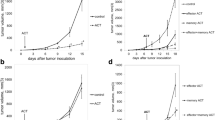Abstract
Background: For the relatively nonimmunogenic B16-F10 murine melanoma, it has been found that genetically engineered expression of granulocyte-macrophage colony-stimulating factor (GM-CSF) but not interleukin (IL)-2, IL-4, or interferon-gamma (IFN-γ) resulted in a vaccine that could induce resistance to rechallenge. Because T cells from lymph nodes draining the sites of some progressive tumors can mediate tumor regression after in vitro activation, it seemed possible that even apparently nonimmunogenic melanoma cells might induce similar preeffector cells in the vaccine-draining lymph nodes (DLNs).
Methods: C57BL/6 mice were vaccinated with B16-F10 cells that were either unmodified or genetically modified to produce IL-2, IL-4, GM-CSF, or IFN-γ. DLNs were harvested 10 days after vaccination for adoptive immunotherapy (AIT). The DLN cells were activated with bryostatin 1 and ionomycin (B/I), expanded for 10 days in culture, and transferred to mice with 3-day pulmonary metastases. Pulmonary nodules were counted 14 days after AIT.
Results: Adoptive transfer of expanded DLN lymphocytes sensitized by inoculation of WT B16-F10, or IL-4, GM-CSF, or IFN-γ expressing cells significantly reduced pulmonary metastases. Despite the spontaneous regression of IL-2-transduced B16-F10 tumors, DLN from mice inoculated with IL-2 producing B16 cells had little or no antitumor activity.
Conclusions: B16-F10 vaccination strategies that apparently do not induce systemic immunity can effectively sensitize DLN preeffector cells.
Similar content being viewed by others
References
Dranoff G, Jaffee E, Lazenby A, et al. Vaccination with irradiated tumor cells engineered to secrete murine granulocyte-macrophage colony-stimulating factor stimulates potent, specific, and long-lasting anti-tumor immunity.Proc Natl Acad Sci U S A 1993;90:3539–43.
Colombo MP, Ferrari G, Stoppacciaro A, et al. Granulocyte colony-stimulating factor gene transfer suppresses tumor-igenicity of a murine adenocarcinoma in vivo.J Exp Med 1991;173:889–97.
Gansbacher B, Zier K, Daniels B, Cronin K, Bannerji R, Gilboa E. Interleukin 2 gene transfer into tumor abrogates tumorigenicity and induces protective immunity.J Exp Med 1990;172:1217–24.
Golumbek PT, Lazenby AJ, Levitsky HI, et al. Treatment of established renal cancer by tumor cells engineered to secrete interleukin 4.Science 1991;254:713–6.
Krauss JC, Storme SE, Chang AE, Shu S. Enhancement of immune reactivity in the lymph nodes draining a murine melanoma engineered to elaborate interleukin-4.J Immunother 1994;16:77–84.
Tuttle TM, Inge TH, Bethke KP, McCrady CW, Pettit GR, Bear HD. Activation and growth of murine tumor-specific T cells which have in vivo activity with bryostatin 1.Cancer Res 1992;52:548–53.
Pettit GR, Day JF, Harwell JL, Wood HB. Antineoplastic components of marine animals.Nature 1970;227:962–3.
Tuttle TM, Inge TH, Lind DS, Bear HD. Adoptive transfer of bryostatin 1-activated T cells provides long-term protection from tumour metastases.Surg Oncol 1992;1:299–307.
Herlyn M, Kaprowski H. Melanoma antigens. Immunological and biological characterization and clinical significance.Ann Rev Immunol 1988;6:283–308.
Fidler IJ. Biological behavior of malignant melanoma cells correlated to their survival in vivo.Cancer Res 1975;35:218–24.
Hart IR. The selection and characterization of an invasive variant of the B16 melanoma.Am J Pathol 1979;97:587–600.
Maslow DE. Tabulation of results on the heterogeneity of cellular characteristics among cells from B16 mouse melanoma cell lines with different colonization potentials: a summary of sixty reports.Invasion Metastasis 1989;9:182–91.
Prehn RT, Main JM. Immunity to methylcholanthrene-induced sarcomas.J Natl Cancer Inst 1957;18:769–78.
Geiger JD, Wagner PD, Cameron MJ, Shu S, Chang AE. Generation of T cells reactive to the poorly immunogenic B16-BL6 melanoma with efficacy in the treatment of spontaneous metastases.J Immunother 1993;13:153–65.
Keller R, Keist R, Leist TP, Van Der Meide PH. Resistance to a non-immunogenic tumor, induced byCorynebacterium parvum orListeria monocytogenes, is abrogated by anti-interferon gamma.Int J Cancer 1990;46:687–90.
Hock H, Dorsch M, Kunzendorf U, et al. Vaccinations with tumor cells genetically engineered to produce different cytokines: effectively not superior to a classical adjuvant.Cancer Res 1993;53:714–6.
Dye ES, North RJ, Mills CD. Mechanisms of antitumor action ofCorynebacterium parvum. I. Potentiated anti-tumor-specific immunity and its therapeutic limitations.J Exp Med 1981;154:609–20.
Hock H, Dorsch M, Kunzendorf U, et al. Vaccination with tumor cells genetically engineered to produce different cytokines: effectivity not superior to a classical adjuvant.Cancer Res 1993;53:714–6.
Mitchison NA, Phil D. Studies on the immunological response to foreign tumor transplants in the mouse. I. The role of lymph node cells in conferring immunity by adoptive transfer.J Exp Med 1955;102:157–77.
Shu S, Chou T, Sakai K. Lymphocytes generated by in vivo priming and in vitro sensitization demonstrate therapeutic efficacy against a murine tumor that lacks apparent immunogenicity.J Immunol 1989;143:740–8.
Schmidt W, Schweighoffer T, Herbst E, et al. Cancer vaccines: the interleukin 2 dosage effect.Proc Natl Acad Sci U S A 1995;92:4711–4.
Zoller M, Strubel A, Hammerling G, Andrighetto G, Raz A, Ben Ze'ev A. Interferon-gamma treatment of B16 melanoma cells: opposing effects for non-adaptive and adaptive immune defense and its reflection by metastatic spread.Int J Cancer 1988;41:256–66.
Hara I, Nguyen H, Takechi Y, Gansbacher B, Chapman PB, Houghton AN. Rejection of mouse melanoma elicited by local secretion of interleukin-2: implicating macrophage without T cells or natural killer cells in tumor rejection.Int J Cancer 1995;61:253–60.
Maas G, Schmidt W, Berger M, et al. Priming of tumor-specific T cells in the draining lymph nodes after immunization with Interleukin-2—secreting tumor cells: three consecutive stages may be required for successful tumor vaccination.Proc Natl Acad Sci U S A 1995;92:5540–4.
Author information
Authors and Affiliations
Rights and permissions
About this article
Cite this article
Lipshy, K.A., Kostuchenko, P.J., Hamad, G.G. et al. Sensitizing T-lymphocytes for adoptive immunotherapy by vaccination with wild-type or cytokine gene-transduced melanoma. Annals of Surgical Oncology 4, 334–341 (1997). https://doi.org/10.1007/BF02303584
Received:
Accepted:
Issue Date:
DOI: https://doi.org/10.1007/BF02303584




